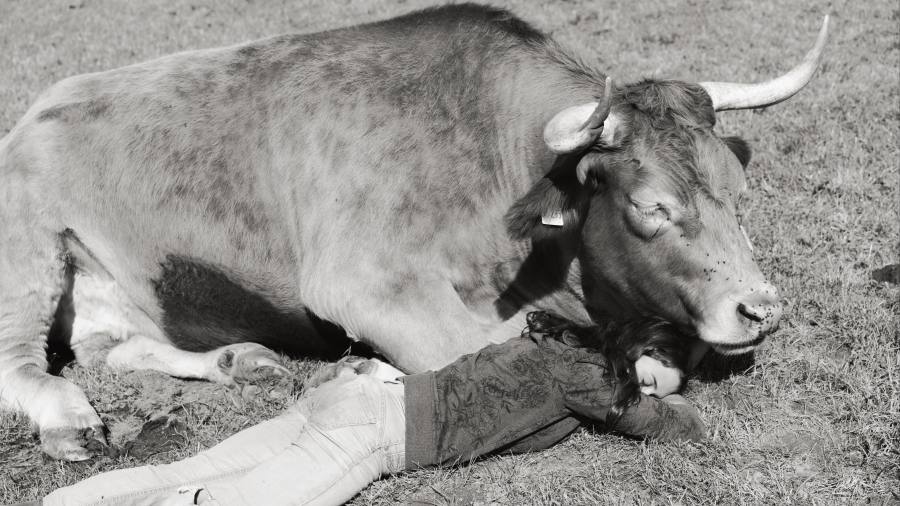Can humans and other animals ever really be companions? Our dogs don’t understand where their food comes from, or why we take them to the vet. Our cats don’t know where we go during the day (and vice versa). We have no idea what it would be like to see the world as a cow or a crow. There are chasms of power and incomprehension.
Yana Wernicke’s work reminds us that compassion can cross these chasms. Her textless book of photographs, entitled simply Companions, reveals the touch of a pig’s ear against a human leg, the firmness of a cow’s underbelly, the sensation of shared existence under the trees. We see animals who were bred to be killed, but whose emotional and physical existence has now implanted themselves on to human lives.
Wernicke, 32, is influenced by the work of John Berger, the art critic who argued that humans had become increasingly removed from other species yet longed for connection with them. The photographs show Julie and Rosina, two German women, and some of the cows and pigs who they have rescued at separate sites across Germany. The tenderness between species is so unfamiliar that it appears almost a magic trick.
“I really was intrigued by this aspect of touching animals and how animals touch back. Of course, we humans touch with hands, but it was interesting to see how a cow touches back,” says Wernicke. “There’s a lot of leaning, and opening up vulnerable areas of the body.”
To rescue animals is a commitment, a change to our way of life. But just to talk of companionship is an act of activism. That was true when Elliot Katz — aptly named — founded the charity In Defense of Animals in San Francisco in 1983 and campaigned for pets to be referred to instead as “companion animals”.
Katz had trained as a vet at Cornell, having been nearly thrown out for refusing to do practice surgeries on live dogs. When campaigning, he sometimes settled for humans calling themselves “pet guardians” as a compromise. His point was that animals should be considered not simply property, but sentient beings with their own needs. When this happened, he believed, fewer would be discarded by their “owners” and fewer would end up euthanised in shelters.
Katz, who died in 2021, had some success in California, although today many animal-lovers prefer to speak of themselves as “parents” of cats and dogs, a term that doesn’t go as far in recognising the animals’ right to autonomy. Legal systems still struggle with how to deal with subjects that are neither objects nor humans.
Creating companionship with livestock is a harder ask. Berger himself romanticised how peasants in the French Alps kept and slaughtered pigs. Most of us, living in cities and towns, are not used to seeing or touching livestock. We assume pigs and cows are dirty, brutish, uncuddly. We wouldn’t want to muddy our clothes, to expose ourselves to a kick in the ribs, to break the norms of behaviour. Close observation can change this perspective. “I saw so many similarities to my dog,” says Wernicke. “I wanted to show that there’s not that much of a difference.”
She has previously looked at German colonialism in Cameroon, leading her to the collections of dead animals in the archives of German museums. Influenced by the philosopher Vilém Flusser, she also tried following animals — donkeys, wolves, cats — in the Italian Alps, being led by them and in doing so, rewriting her own path.
Even in cities, far from farms and wolves, we have chances for companionship. When I work on my computer at home, quite often my cat jumps on to the desk and nestles between my forearms. When I walk outside, my eyes often meet those of squirrels and foxes. However different our experiences, we are spending time together — and that act forms the basis for companionship. Sometimes we feel lonely, even though we are surrounded by other people. The company of other animals — foxes, frogs, even pigeons — is an antidote.
Companions invites us to draw parallels between our bodies and those of the animals we eat. It asks us why we cannot draw closer to other species. Would it be so out of place to hold their skin, to dirty our legs in the mud? Yes, and also no. We are not the rescuers, Julie and Rosina, but perhaps we yearn to be.
Henry Mance is the FT’s chief features writer and author of ‘How To Love Animals’. ‘Companions’ is published this month by Loose Joints
Follow @FTMag on Twitter to find out about our latest stories first
